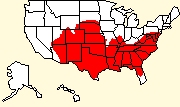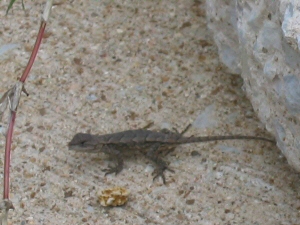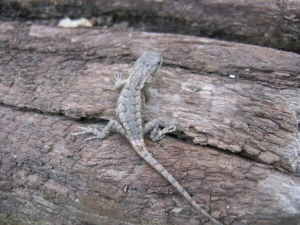|
Northern Fence Lizard
|
- Order: Squamata (scaled reptiles)
- Suborder: Lacertilia (=Sauria) (lizards)
- Family: Iguanidae (iguanid lizards)
- Subfamily: Phrynosomatinae (spiny and horned
lizards)
- Genus: Sceloporus (fence and spiny
lizards)
|
| Also known as: (all undulatus)
eastern fence lizard, fence swift |
Scientific Name: Sceloporus
undulatus hyacinthinus (Green, 1818) |
| Habitat: A variety of
environments, from arid regions to woodland. Often seen near
brush piles and fences. |
Skelos="leg," porus="pore"
(referring to femoral pores on the legs), undulatus=
"wavelike pattern" (dorsal pattern), huakinth-os="dark
blue," inus="belonging to" (in reference to
the blue belly patches exhibited by males)
|
| Length: Up to 7.5 inches. |
|
| Food: Insects,
arachnids, snails, millipedes. |
 |
|
This baby (about 2.5 inches long) lizard was found
in a pile of concrete rubble west of Branson, Missouri. These
lizards are fairly abundant wherever they are found. |
 |
| The lizard at right is the
second lizard I found in the area, also a baby. It was
hiding under the log before I photographed it.
The range map here indicates the range of the entire species,
Eastern Fence Lizard (Sceloporus undulatus), not just this
subspecies (there are 8 subspecies in the US!).
|
 |
| Recent research indicates Sceloporus
lizards may have an agent in their blood rendering them immune to
Lyme disease. |
|
| See also the fence lizards on
the Arkansas, Colorado,
New Mexico, and Utah
pages. |
|
|
|
|